French balloonist and inventor of the frameless parachute
| André-Jacques Garnerin | |
|---|---|
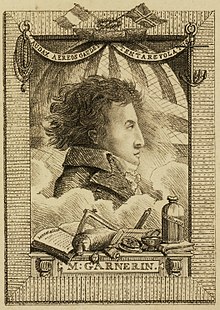 | |
| Born | (1769-01-31)31 January 1769 Paris, France |
| Died | 18 August 1823(1823-08-18) (aged 54) Paris, France |
| Known for | Pioneer balloonist and parachuter |
André-Jacques Garnerin (31 January 1769 – 18 August 1823) was a French balloonist and the inventor of the frameless parachute. He was appointed Official Aeronaut of France.
Biography
André-Jacques Garnerin was born in Paris. During the first phase of the French Revolutionary Wars (1792–1797), he was captured by British troops. Subsequently, he was turned over to the Austrians and held as a prisoner of war in Buda, Hungary, for three years.
Balloons and parachutes
Ballooning
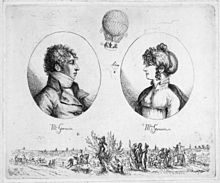
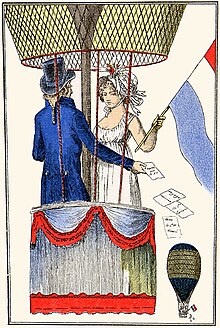
André-Jacques Garnerin was a student of the ballooning pioneer Professor Jacques Charles. Garnerin was heavily involved in the flight of hot air balloons, and worked with his older brother, Jean-Baptiste-Olivier Garnerin (1766–1849), in most of his ballooning activities. His significant contributions to ballooning and his expertise led to his appointment as the Official Aeronaut of France.
Garnerin began experiments with early parachutes based on umbrella-shaped devices and carried out the first frameless parachute descent (in the gondola) with a silk parachute on 22 October 1797 at Parc Monceau, Paris (1st Brumaire, Year VI of the Republican calendar). Garnerin's first parachute was made of white canvas with a diameter of approximately 23 feet (7 m). The umbrella was closed before he ascended, with a pole running down its center and a rope running through a tube in the pole, which connected it to the balloon.
Garnerin rode in a basket attached to the bottom of the parachute; at a height of approximately 3,000 feet (1,000 m) he severed the rope that connected his parachute to the balloon. The balloon continued skyward while Garnerin, with his basket and parachute, fell. The basket swung violently during descent, then bumped and scraped when it landed, but Garnerin emerged uninjured.

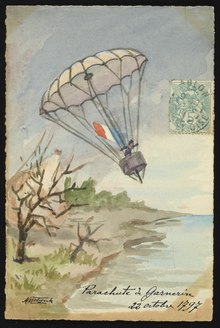
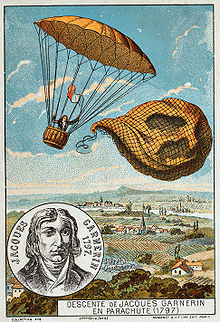
Garnerin went on to stage regular tests and demonstration of his parachute at Parc Monceau, Paris. On 22 October 1797, his parachute descent became a cause célèbre, particularly when he announced in 1798 that his next flight would include a woman as a passenger. Although the public and press were in favor, Garnerin was forced to justify his project before the officials of the Central Bureau of Police.
They were concerned about the effect that reduced air pressure might have on the organs of the delicate female body and loss of consciousness, plus the moral implications of flying in such close proximity. Unsatisfied with Garnerin's responses, the police issued an injunction against him, forbidding the ascent on the grounds that the young woman was committing herself to the venture without fully understanding the possible outcomes.
After further consultation with both the Minister of the Interior and the Minister of the Police the injunction was overturned on the grounds that "there was no more scandal in seeing two people of different gender ascend in a balloon than it is to see them jump into a carriage." They also agreed that the decision of the woman showed proof of her confidence in the experiment and a degree of personal intrepidity.
Citoyenne Henri had already been chosen, so when the ban was lifted Garnerin was ready to proceed. He advertised the ascent in L'Ami des Lois (a Parisian newspaper published from 1795 to 1798) :
The young Citoyenne who will accompany me is delighted to see the day approach for the journey. I shall ascend with her from the Parc Monceau, some time during the next ten days.
On 8 July 1798 a large number of spectators gathered in the Parc Monceau to witness the ascent. By all accounts Citoyenne Henri was young and beautiful, and she and Garnerin took several turns around the park to the applause of the crowd before she was assisted into the basket of the balloon by the astronomer Jérôme Lalande. The balloon trip passed without incident and the journey ended at Goussainville about 30 kilometres (19 mi) to the north of Paris.
Touring England
André-Jacques held the position of Official Aeronaut of France, so with his wife Jeanne Geneviève he visited England in 1802 during the Peace of Amiens and the couple completed a number of demonstration flights. In the evening of 21 September 1802, André-Jacques ascended in his hydrogen balloon from the Volunteer Ground in North Audley Street, Grosvenor Square and made a parachute descent to a field near St Pancras. This gave rise to the English popular ballad:
- Bold Garnerin went up
- Which increased his Repute
- And came safe to earth
- In his Grand Parachute.
He also made his second English balloon ascent with Edward Hawke Locker on 5 July 1802 from Lord's Cricket Ground, travelling the 17 miles (27.4 km) from there to Chingford in just over 15 minutes and carrying a letter of introduction signed by the Prince Regent to give to anyone should he crash land. However, when the war between France and Great Britain resumed they were forced to pack up and return to the continent where, on 3–4 October 1803, he covered a distance of 245 miles (395 km) between Paris and Clausen, Germany, with his balloon.
Family
In most of his ballooning activities Garnerin worked with his older brother Jean-Baptiste-Olivier Garnerin (1766–1849).
Jeanne Garnerin
His student Jeanne Geneviève Labrosse, who later became his wife, was both a balloonist and the first female parachutist. Labrosse first flew on 10 November 1798, one of the earliest women to fly in a balloon, and on 12 October 1799, Labrosse was the first woman to parachute, from an altitude of 900 meters.
Elisa Garnerin
His paternal niece Elisa Garnerin, (born 1791), learned to fly balloons at age 15 and made 39 professional parachute descents from 1815 to 1836 in Italy, Spain, Russia, Germany, and France.
Death
On 18 August, 1823, at the age of 54, Garnerin was working on the construction of a new balloon. While walking around the construction site, he was struck by a falling beam which killed him instantly.
Legacy
Garnerin's first parachute jump was commemorated by Google in a Google Doodle on 22 October 2013.
Notes
- In 1804 Jérôme Lalande introduced a vent in the canopy to eliminate violent oscillations.
- Parc Monceau is in the 8th arrondissement of Paris and is famed for Garnerin's public exploits. It was formerly known as "Parc de Mousseaux" and is referred to as such in many sources. (Mousseaux-sur-Seine is a small town approximately 70 kilometres from Paris.)
- Elizabeth Garnerin was especially popular in Italy, where she was hailed as the "Prima Aeroporista" (or First Parachutist) of France when she made her twenty-second and twenty-third descents in Milan (5 March and 5 April 1824). The crowds were delighted when she waved both French and Italian flags from the basket.
References
- ^ William Shepard Walsh (1913). A Handy Book of Curious Information: Comprising Strange Happenings in the Life of Men and Animals, Odd Statistics, Extraordinary Phenomena, and Out of the Way Facts Concerning the Wonderlands of the Earth. J. B. Lippincott Company.
- ^ Encyclopædia Britannica – André-Jacques Garnerin
- Poniatowski, Michel (1983). Garnerin. Le premier parachutiste de l'histoire. Paris: Michel.
- ^ Soden, Garrett (2005). Defying Gravity: Land Divers, Roller Coasters, Gravity Bums, and the Human Obsession with Falling. W. W. Norton & Company. pp. 21–22. ISBN 978-0-393-32656-7. Retrieved 24 February 2009.
- Techno Science – Profile Andre Garnerin
- Gutenberg – Genesis of Napoleonic Propaganda, Hanley
- History Today Volume: 52 Issue: 9 2002 – Monsieur Garnerin Drops In by John Lucas
- Flights of Fancy Archived 1 January 2006 at the Wayback Machine
- A topographical and historical account of the parish of St. Mary-le-Bone: comprising a copious description of its public buildings, antiquities, schools, charitable endowments, sources of public amusement, &c. with biographical notices of eminent persons. Illustrated with six views and a map. J. Smith. 1833. p. 203.
- Image of the second ascent
- ^ Duhem, Jules (1943). Histoire des idées aéronautiques avant Montgolfier. Nouvelles Editions Latines. p. 263.
- Science Photo Library – Elisa Garnerin
- Aeronautics and Space Flight Collections by Catherine Scott, 1985
- "Women in sports – Elisa Garnerin". Archived from the original on 2 May 2016. Retrieved 10 July 2012.
- Poiron, Yohann (22 October 2013). "André-Jacques Garnerin célébré pour l'anniversaire du 1er saut en parachute en doodle". BlogNT : le Blog des Nouvelles Technologies (in French). Retrieved 9 January 2022.
- "216th Anniversary of the First Parachute Jump". 22 October 2013. Retrieved 12 June 2016.
Other sources
- Walsh, William (1913). A Handy Book of Curious Information. London: Lippincott. pp. 942. Searchable at Internet Archive – A handy book of curious information by William Shepard Walsh
- "World's First Parachute Jump made in 1797". George Galloway essay on Andre-Jacques Garnerin Archived 14 February 2004 at the Wayback Machine
- M F Wright – profile of Andre Garnerin
- From The Big Umbrella, by John Lucas, Drake Publishers Inc. Great Britain, 1973.
- The Silken Angels, (early 1960s)
- Parachuting, Dan Poynter
External links
- Brief biography and picture
- Additional information on Garnerin
- André-Jacques Garnerin biography and picture